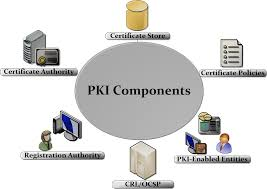Compare and contrast PKI and Kerberos Description 3. Compare and contrast PKI and Kerberos. 4. PKI has not been widely successful, partly because users don’t trust digital signatures. Give some reasons for that distrust.

5. Suggest some ways to address the “crypto dilemma,” along with the pros and cons of each. 6. A 2,000-bit message is used to generate a 256-bit hash. One the average, how many other messages could be expected to generate the same hash value? What does this tell us about the length of a hash as compared to the length of the message? 7. Is 3,141,592,514 a prime number? Why or why not? 8. Modular arithmetic is used in public key ciphers. What is the value of X for each of the following: a. X = 1,195 mod 26 b. X = 3 mod 3,013,989 a. X = 20 mod 3 b. X = 30 mod 3 9. Compare and contrast Pretty Good Privacy, as we used it in our class this semester, and PKI. 10. What is the purpose of the Diffie-Hellmann key exchange algorithm? 11. What are some potential vulnerabilities of online shopping cart applications? 12. Bob picked N=91 for use in an RSA-encrypted message. Since N is part of the public key, Alice was able to crack Bob’s message by determining the values of p and q that Bob used. What values of p and q did she determine?
Compare and contrast PKI and Kerberos Computer Program
13. You’ve been tasked by your boss to design a computer program that can detect encrypted files. List some ways that you could accomplish this. 14. Using RSA, let p = 19, q = 13 and e = 5. Which of these is the complete private key: a. (169, 247) b. (173, 247) c. (169, 216) d. (173, 216) e. None of the above. (For full credit, please show your reasoning.) 15. Suppose that Eve runs a key server. Alice downloads a key from the key server which Eve claims is Bob’s public key. Bob downloads a key from the key server which Eve claims is Alice’s public key. Given that Alice and Bob both assume that they have the correct public keys for the other party, and assuming that Eve can intercept any messages passed between Alice and Bob, is there any way that Eve can read the encrypted communications between the two parties? If so, how could she do it, and would Bob or Alice know that Eve was reading their messages? How could Bob and Alice mitigate this situation? 16. What is a hash function collision? Why are potential hash collisions not considered to be a serious vulnerability? 17. Briefly describe a situation where cryptographic techniques can aid the battle against malware. Describe a second situation where cryptographic techniques can hinder the battle against malware. 18. Give an example of potential vulnerability of the Diffie-Hellman key exchange. 19. How can a system for multi-level access control be implemented for government and military applications? What might access rules look like for such a system? 20. Please concur with, dispute, or qualify the following statement. Performing a frequency analysis would be a good starting point for cracking an RSA-encrypted message. (Please be sure to include your rationale.) 21. What security features could be provided without changing the mail delivery infrastructure, i.e., by only running special software at the source and destination? 22. Computer system #1 requires login passwords to be eight upper-case letters.
Compare and contrast PKI and Kerberos Required References
How many different passwords are there for system #1? Computer system #2 requires login passwords to be eight characters, which may be upper or lower-case letters, the numbers 0 through 9, and the characters $ and %. How many different passwords are there for system #2? 23. Why do many operating systems store password hashes, rather than the password itself? 24. What are some areas of computer/network security that cryptography does not provide protection? 25. How does Kerberos help with the key management problem?




